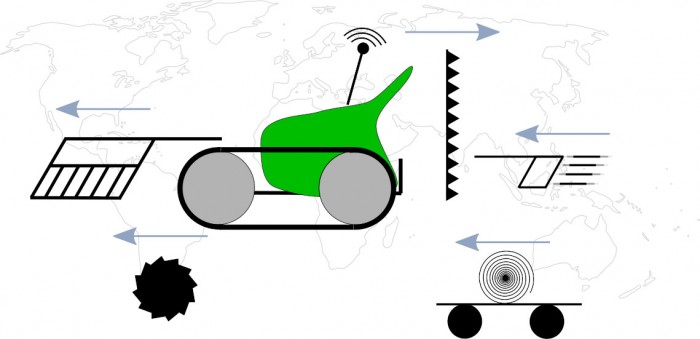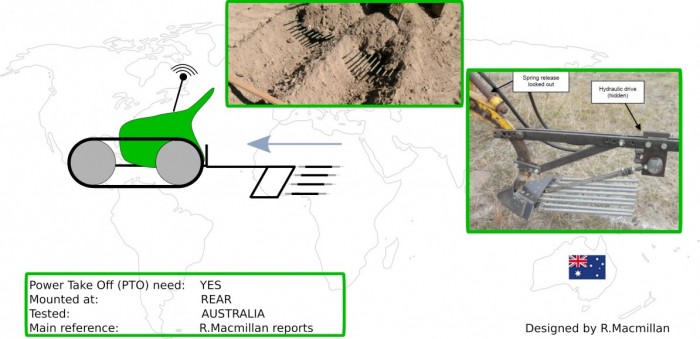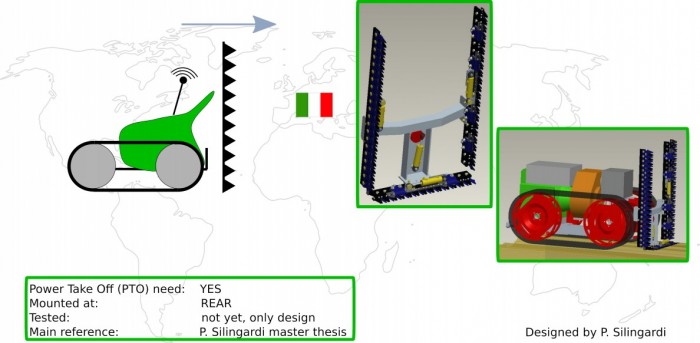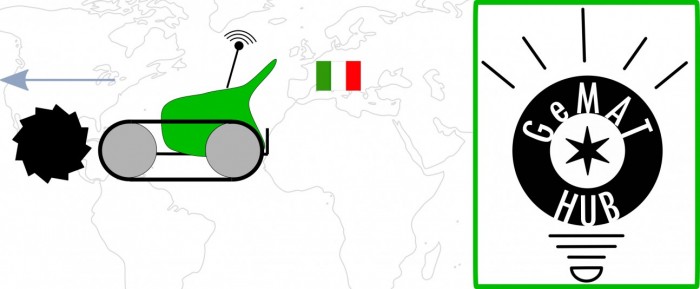Implements
Disarmadillo project has been going on for more than 10 years thanks to the commitment and interest of many partners around the world.
Many implements, that can be mounted on Disarmadillo, have been designed by partners. Some have been developed into a prototype that has been tested, some others are still in the form of designs or concepts. All have the potential to be used and are presented here together with relative references deepening the work behind them. Please scroll down for more information and contact us of you are interested in working on them further or developing new tools.

Rake
Originally named Ground Processing Tool (GPT), it has been designed and first prototyped in Italy and later on manufactured, prototyped and tested in Jordan.
It is aimed at processing the soil at constant depth and expose landmines by lifting them up on soil surface, without actuating them.
It is specifically targeting areas where soil is loose (soil cohesion C = 10kPa and angle of internal friction =30°), typically found in Sri Lanka (country for which it was originally designed for), Jordan, Western Sahara.

The design of the Rake is detailed in Emanuela's PhD thesis, available here. Drawings are in the appendix. The paper "Agricultural derived tools for ground processing in humanitarian demining operations: set up of a testing facility in Jordan" describes the design of the Rake and its tests done in Jordan.
Vibrating sieve
The Vibrating Sieve has been designed and prototyped in Australia by Ross Macmillan, Senior Fellow in Agricultural Engineering at the University of Melbourne.
As the Rake, it is aimed at processing the soil at constant depth and expose landmines by lifting them up on soil surface, by means of a vibrating movement, without actuating them.
It is targeting areas where soil cohesion wouldn't allow a fixed rake to sieve the ground and lift landmines upwards.

The design of the Vibrating Sieve is detailed in Ross's report.
Vegetation cutter
The Vegetation Cutter has been designed by Paolo Silingardi, during his master thesis in mechanical engineering at the University of Genova, Italy.
It is aimed at cutting vegetation in front and at both sides of Disarmadillo, to make space for the machine to pass.
It is targeting areas covered by light and medium vegetation, including palm leaves. It is employing off the shelf cutting bars actuated by cylinders connected in series to an additional cylinder moved by an eccentric wheel connected to the pto.
The design of the Vegetation Cutter is explained in the paper "Power tillers for demining in Sri Lanka: vegetation cutting module".
Lizards
Several types of Lizards, to be carried in loci by Disarmadillo, have been designed by students from the University of Genova, Italy.
They are targeting areas covered by thick vegetation, where some additional data collection, in the form of REST sampling, spectrography or other sensors might be needed before cutting vegetation.
Lizards are able to crawl in thick vegetation, thanks to bio-inspired locomotion systems, and are powered by Disarmadillo via umbilical.

The design of the Lizards is explained in the papers "Cost-effective robots for mine detection in thick vegetation" and "The Pmar lab in humanitarian demining effort".
Ideas...
Some implements, such as a roller to be mounted in front of Disarmadillo to reduce the risks of explosions underneath the machine when tools mounted at rear are used, or a range of inspection tools that originate and use power from Disarmadillo to enter hazardous areas, are still only in the form of ideas. But they could become prototypes soon thanks to new collaborations that keep on being established.
Snail Aid has recently submitted a proposal to work with the Italian Institute of Technology (IIT), a leader research institute in the field of robotics, to establish the GeMAT Hub, the Genova Mine Action Technology Hub, dedicated to the design of new technologies for mine action. The work will start by improving Disarmadillo, by working both on the machine, that will become a kit to add-on any type of powertiller, and on new implements.

